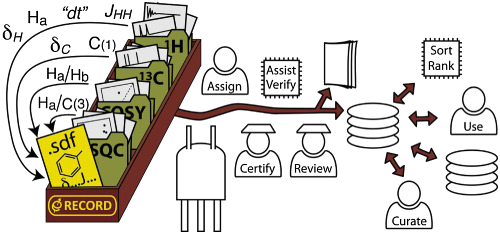- NMReDATA, a standard to report the NMR assignment and parameters of organic compounds
Pupier, M.; Nuzillard, J.-M.; Wist, J.; Schlörer, N. E.; Kuhn, S.; Erdelyi, M.; Steinbeck, C.; Williams, A. J.; Butts, C.; Claridge, T. D. W.; Mikhova, B.; Robien, W.; Dashti, H.; Eghbalnia, H. R.; Farès, C.; Adam, C.; Kessler, P.; Moriaud, F.; Elyashberg, M.; Argyropoulos, D.; Pérez, M.; Giraudeau, P.; Gil, R. R.; Trevorrow, P.; Jeannerat, D.
Magn. Reson. Chem. 2018, 56, 703-715

Even though NMR has found countless applications in the field of small molecule characterization, there is no standard file format available for the NMR data relevant to structure characterization of small molecules. A new format is therefore introduced to associate the NMR parameters extracted from 1D and 2D spectra of organic compounds to the proposed chemical structure. These NMR parameters, which we shall call NMReDATA (for nuclear magnetic resonance extracted data), include chemical shift values, signal integrals, intensities, multiplicities, scalar coupling constants, lists of 2D correlations, relaxation times and diffusion rates. The file format is an extension of the existing SDF (Structure Data Format), which is compatible with the commonly used MOL format. The association of an NMReDATA file with the raw and spectral data from which it originates constitutes an NMR record. This format is easily readable by humans and computers and provides a simple and efficient way for disseminating results of structural chemistry investigations, allowing automatic verification of published results, and for assisting the constitution of highly needed open-source structural databases.
DOI : 10.1002/mrc.4737
archive ouverte unige:106258
